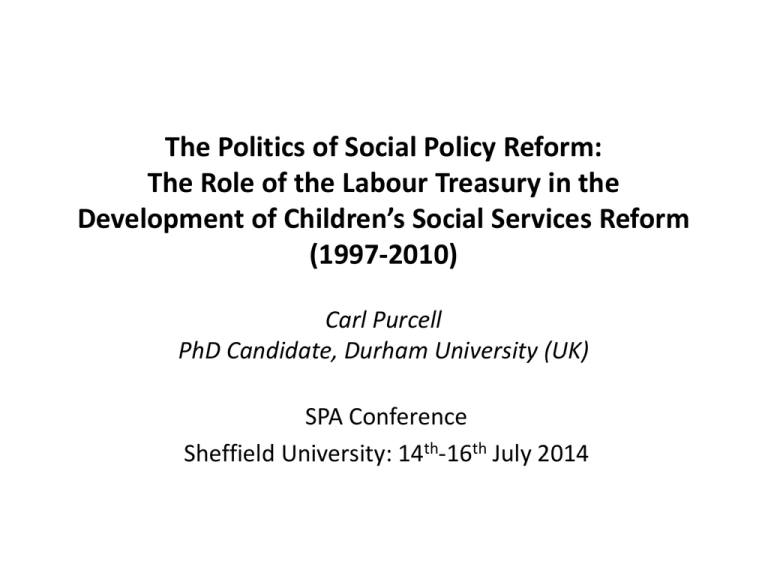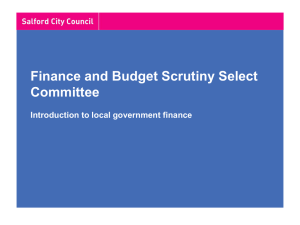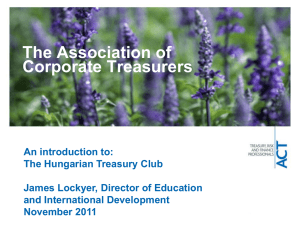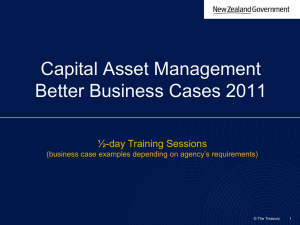Carl Purcell PhD Candidate, Durham University (UK)
advertisement

The Politics of Social Policy Reform: The Role of the Labour Treasury in the Development of Children’s Social Services Reform (1997-2010) Carl Purcell PhD Candidate, Durham University (UK) SPA Conference Sheffield University: 14th-16th July 2014 Introduction – Do Political Parties Matter? • Mair (2013) – primary focus of party political leaders is to be elected to office. Parties are now disconnected from traditional constituencies. • New Labour appeared to accept the constraints imposed by global financial markets and distanced itself from ‘old’ Labour’s historic commitment to economic redistribution. • Competition between the main parties in relation to social policy is now usually framed in terms of managerial competence rather than fundamental differences in priorities – reliance on ‘independent experts’, evidence of ‘what works’, opinion polls. • Under ‘post-democracy’ (Crouch) parties of the centre-left have opened themselves to the influence of the global firm, but ties to traditional constituencies have not been broken entirely. • Tensions within New Labour between Blair’s electoral focus and Brown’s stronger commitment to the ‘old’ politics of redistribution were evident in the development of the Every Child Matters programme which required a significant re-organisation of local children’s services as part of the Treasury’s strategy to tackle child poverty. Did New Labour Matter? • ‘Soft Thatcherite’ or ‘Post-Thatcherite’? (Levitas 2005 v Driver and Martell 2006) • A coherent ‘social investment’ policy paradigm? (Dobrowolsky and Lister 2008) - Universal education and childcare - Problem young people - Child poverty • Reassessing Blair’s New Labour - what was the Treasury’s contribution to social policy? • The policy process lens - Helps us to look beyond the non-ideological discourse of ‘modernisation’ and ‘social investment’. Policy is “what happens rather than what politicians say will happen” (Hill). - Examines interactions between party political, civil service and nongovernmental policy makers. Models of the British policy-making process Governance networks (Rhodes 1997; 2007) • Policy-making is driven by self-organizing networks of non-governmental public, private and third sector organisations. Government’s role is limited to network governance. • Case studies of policy-making under New Labour contradict this, highlighting the continued dominance of government hierarchy rather than autonomous networks. Departmental government (Marsh et al 2001; 2003; Marsh 2008) • Policy making is directed by Ministers and senior civil servants supported by a close circle of non-governmental policy experts. • Party leadership lacks the organisational capacity to challenge established departmental policy agendas and policy-making processes. • Stable periods of policy-making are interrupted by ‘shocks’ emanating in the external environment. Party government (Rose 1976) • Departmental policy making takes place within the context of ongoing intra/inter party political conflict over underlying policy priories. • Ruling party has the organisational capacity to challenge departmental policy agendas and policy-making processes. • Policy-making involves ongoing conflict over means and ends - ‘shocks’ are interpreted within competing ideological frameworks. Case Study: Labour’s Every Child Matters (ECM) Reforms • Establishment of local Children’s Trusts fits the profile for network governance • Potential candidate for departmental government – reforms were presented as a technical response to the Victoria Climbie Inquiry (Laming 2003) • Reform process involved both No.10 and the Treasury – was this an example of party government? Method • Long time frame needed to observe change to policy priorities and policy-making processes • Wide range of evidence – interviews, 200+ official publications, media reporting • Interviewees (37): 4 government ministers, 12 senior civil servants,7 local authority directors, 7 charity leaders, 3 political advisers, 4 academic advisers No.10 versus the Treasury • The two New Labours under post-democracy - Blair’s electoral focus – youth offending, anti-social behaviour, teenage pregnancy, truancy, NEETs - Brown’s redistributive child poverty policy framework – financial transfers to families plus increased investment in universal public services in poor communities • The party leadership and service delivery pre-ECM - No.10 supported by the Social Exclusion Unit - New local youth offending teams (YOTS) created alongside nation Youth Offending Board (YJB) - Treasury used spending review process to develop policy proposals - New national units and local partnership boards established by the Treasury to manage the roll out of Sure Start and the Children’s Fund – both focused on ‘joining-up’ local services for children and families in poor communities - Perceived lack of progress in implementation of Sure Start/Children’s Fund feeds the case for structural reform of local authority Social Services departments The ECM Green Paper and the Children Act 2004 • Green paper process established following the 2002 spending review, not in anticipation of Lord Laming’s report • Laming’s recommendations were explicitly focused on child protection and where in line with the existing legislative and policy framework managed by the DoH • The key reforms - New Directorate for Children and Young People created within the DfES – responsibility for children’s social services transferred from DoH - Local authority social services and education departments merged and headed up by new post of Director of Children’s Services (DCS) - DCS required to set up and lead multi-agency Children’s Trust boards • The structural reforms implemented under the Children Act 2004 were designed to embed the Treasury’s broader focus on the life chances of all children and young people – child protection was shoehorned into this universal framework The Development and Implementation of ECM • Initial resistance to reform by social services leaders was unsuccessful, and the new policy agenda was eventually accepted. • Successful resistance to the breadth of Paul Boateng’s (Chief Secretary to the Treasury) ambition was mounted by Charles Clarke (Secretary of State for Education). However, this must be understood in the context of Blair’s commitment to education reform, not simply the power of departmental interests. • Ongoing challenges to the Treasury’s universal framework came from No.10 up until Blair’s resignation. • The Conservatives challenged the Treasury’s universal framework following the Peter Connelly case initially reported in the media in late 2008. Secretary of State Ed Balls was forced to initiate a new programme of social work reform. Conclusion The continued relevance of party government - ECM reforms can only be understood in the context of intra/inter party political conflict over social policy priorities - The ECM reform process was driven by The Treasury’s desire to establish control over the bureaucratic apparatus of central and local government - The Victoria Climbie Inquiry provided the opportunity for the Treasury to push forward its reforms. The reforms were not simply a response to an unanticipated external ‘shock’. Did New Labour matter? - In so far as the Treasury was successful in embedding a redistributive dimension to New Labour social policy, yes it did. - Retreat from the Labour Treasury’s framework under the Coalition reinforces this conclusion.









